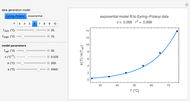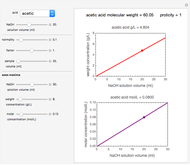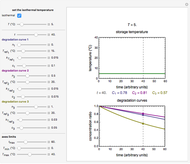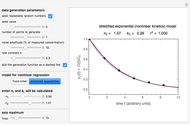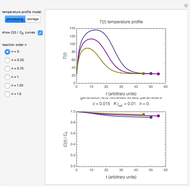Simulating Ascorbic Acid Degradation

Requires a Wolfram Notebook System
Interact on desktop, mobile and cloud with the free Wolfram Player or other Wolfram Language products.
Isothermal chemical degradation of ascorbic acid (AA) can follow, simultaneously, two major pathways: "aerobic," where it is first oxidized to dehydroascorbic acid (DHAA), and "anaerobic," where it is not. The second mechanism is much slower, and thus the degradation curve may appear as having an asymptotic residual concentration of AA. This Demonstration simulates such degradation patterns, which start by following first-order kinetics and end up in an asymptotic concentration ratio. It also simulates dynamic (i.e. nonisothermal) degradation curves during oscillating linearly rising and falling temperature regimes.
Contributed by: Mark D. Normandand Micha Peleg (July 2016)
Open content licensed under CC BY-NC-SA
Snapshots
Details
Snapshot 1: isothermal degradation curve following first-order kinetics with no asymptotic residual
Snapshot 2: nonisothermal degradation curve initially following first-order kinetics and having an asymptotic residual (rising temperature)
Snapshot 3: nonisothermal degradation curve following first-order kinetics with no asymptotic residual (rising temperature)
Snapshot 4: nonisothermal degradation curve initially following first-order kinetics and having an asymptotic residual (falling temperature)
Snapshot 5: nonisothermal degradation curve following first-order kinetics with no asymptotic residual (falling temperature)
The isothermal chemical degradation of L-ascorbic acid (AA) has two major pathways. The first and faster is the "aerobic" mechanism where the AA is first oxidized to dehydroascorbic acid (DHAA), which subsequently decomposes. The second is the much slower "anaerobic" mechanism where the AA molecules themselves decompose. (Since the DHAA formed in the aerobic pathway has a vitamin activity, the decrease in the AA concentration is not synonymous with vitamin C loss. Nevertheless, it is more convenient to monitor only the diminishing concentration of AA and treat it as a marker.)
When the two mechanisms operate simultaneously, experimentally observed degradation curves, based on the diminishing AA concentration, frequently follow the model  where
where  is the time-dependent concentration ratio
is the time-dependent concentration ratio  ,
,  is the asymptotic residual concentration ratio
is the asymptotic residual concentration ratio  , and
, and  a temperature-dependent rate constant [1, 2]. Thus, where
a temperature-dependent rate constant [1, 2]. Thus, where  , the decay follows the conventional first-order kinetics.
, the decay follows the conventional first-order kinetics.
The temperature-dependence of  has been traditionally described by the Arrhenius equation [1, 2]. It has been shown that experimental
has been traditionally described by the Arrhenius equation [1, 2]. It has been shown that experimental  versus
versus  data described by the Arrhenius equation can also be described by the much simpler exponential model
data described by the Arrhenius equation can also be described by the much simpler exponential model  without sacrificing the fit [3–5]. In this model,
without sacrificing the fit [3–5]. In this model,  is the rate constant at an arbitrary reference temperature
is the rate constant at an arbitrary reference temperature  , both
, both  and
and  are in °C, and
are in °C, and  is a characteristic constant having units
is a characteristic constant having units  . Incorporating
. Incorporating  so defined into the isothermal degradation equation renders the general isothermal model
so defined into the isothermal degradation equation renders the general isothermal model  .
.
For a nonisothermal temperature history  , we assume that the AA's momentary decay rate is the isothermal rate at the momentary temperature
, we assume that the AA's momentary decay rate is the isothermal rate at the momentary temperature  , at a time
, at a time  that corresponds to its momentary concentration ratio
that corresponds to its momentary concentration ratio  [4]. Implementing this assumption renders the general degradation model in the form of the numerical solution for
[4]. Implementing this assumption renders the general degradation model in the form of the numerical solution for  of the rate equation
of the rate equation  where
where  . The boundary condition is
. The boundary condition is  .
.
In this Demonstration, you can choose between simulating isothermal degradation patterns of AA at chosen constant temperatures and dynamic degradation patterns of AA at linearly rising and falling oscillating temperatures as examples. You can vary the AA's degradation kinetic parameters, namely,  ,
,  , and
, and  . You can also vary the chosen constant temperature
. You can also vary the chosen constant temperature  or dynamic temperature profile parameters
or dynamic temperature profile parameters  , the initial temperature in °C (
, the initial temperature in °C ( ), the slope of the temperature rise (
), the slope of the temperature rise ( ) or fall (
) or fall ( ) in
) in  units
units  , the temperature oscillation's amplitude in °C, and
, the temperature oscillation's amplitude in °C, and  , their frequency in units of
, their frequency in units of  .
.
Notice that certain combinations of  ,
,  , and
, and  in the dynamic temperature profile equation will render the isothermal solution for the initial temperature
in the dynamic temperature profile equation will render the isothermal solution for the initial temperature  .
.
References
[1] M. C. Viera, A. A. Teixeira, and C. L. M. Silva, "Mathematical Modeling of the Thermal Degradation Kinetics of Vitamin C in Cupuaçu (Theobroma grandiflorum) Nectar", Journal of Food Engineering, 43(1), 2000 pp. 1–7. doi:10.1016/S0260-8774(99)00121-1.
[2] L. Verbeyst, R. Bogaerts, I. Van der Plancken, M. Hendrickx, and A. Van Loey, "Modelling of Vitamin C Degradation during Thermal and High-Pressure Treatments of Red Fruit," Food Bioprocess Technology, 6(4), 2013 pp. 1015–1023. doi:10.1007/s11947-012-0784-y.
[3] M. Peleg, M. D. Normand, and M. G. Corradini, "The Arrhenius Equation Revisited," Critical Reviews in Foods Science and Nutrition, 52(9), 2012 pp. 830–851. doi:10.1080/10408398.2012.667460.
[4] M. Peleg, A. D. Kim, and M. D. Normand, "Predicting Anthocyanins' Isothermal and Non-isothermal Degradation with the Endpoints Method," Food Chemistry, 187, 2015 pp. 537–544. doi:10.1016/j.foodchem.2015.04.091.
[5] M. Peleg, M. D. Normand, and T. R. Goulette, "Calculating the Degradation Kinetic Parameters of Thiamine by the Isothermal Version of the Endpoints Method," Food Research International, 79, 2016 pp. 73–80. doi:10.1016/j.foodres.2015.12.001.
Permanent Citation








